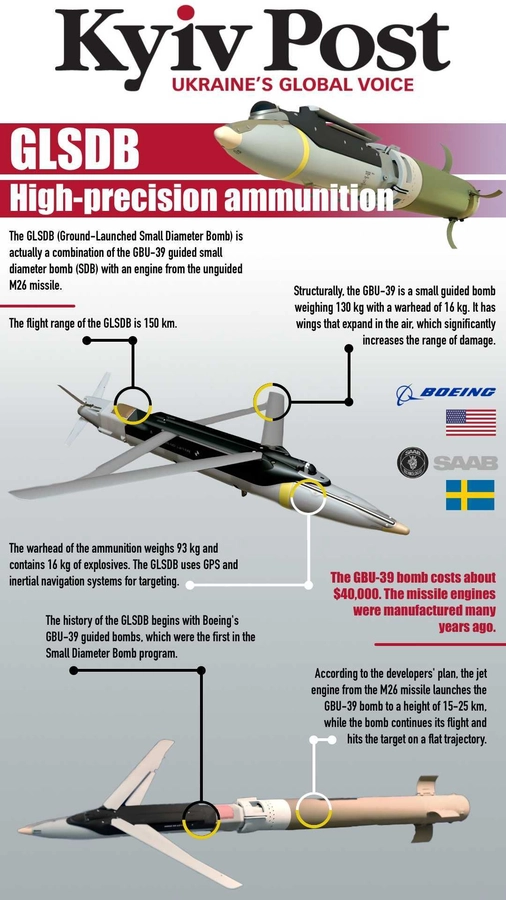Ukraine has been impatiently anticipating the arrival of what it hopes will be another US-provided battlefield weapons system for almost a year.
The Boeing-Saab hybrid missile system the Ground Launched Small Diameter Bomb (GLSDB) was originally slated to be delivered in spring 2023 but a number of technical issues pushed the expected delivery date back several times.
JOIN US ON TELEGRAM
Follow our coverage of the war on the @Kyivpost_official.
Victoria Nuland arrived in Kyiv on Wednesday, in what many saw as being a “rallying the troops” visit intended to ease worries that American aid could be drying up.
On Tuesday the US political journal Politico was announcing the imminent arrival of the GLSDB quoting its sources as saying weapon had been successfully tested and was expected to arrive on the battlefield as soon as Wednesday.
The visit and the news that GLSDB was about to land was probably no coincidence.
Nuland’s words of encouragement to Ukraine prefaced a promise that the US would continue “to provide Ukraine with support, including new investments, new weapons systems, such as the Small Diameter Bomb, which are already on their way to the front.”
Russia has reacted furiously to news of the GLSDB’s arrival in Ukraine.
Russian Ambassador to the United States Anatoly Antonov said: “The irresponsible words by US officials are simply shocking. Confirmation today that another batch of long-range ammunition is on its way to the contact line essentially disavows any White House declarations about its willingness to put the conflict to an end as soon as possible.

US-Ukraine Relations: Where Do Trump and Harris Stand?
“On the contrary, the Administration’s actions indicate its intention to prolong the agony of the Kyiv regime. Even if this means new casualties, including among the civilian population of Russia and Ukraine.”
Why is Russia so worried about GLSDBs?
The GLSDB missile is a clever, post-Cold War Pentagon weapons idea that actually bore fruit.
It was originally an initiative taken by the two giant defense companies in consultation with the US Defense Department who were looking for an adjunct to the HIMARS rocket artillery system.
Boeing-Saab’s solution was to make use of the large numbers of the M26 227mm unguided rockets and GBU 39 small diameter 110-kilogram (250-pound) precision-guided glider bomb still held in the US inventory.
The biggest problems were how to marry the two munitions and engineer them to be able to fire from the existing M270 or a HIMARS launch platforms.
The final product has a range of 150 kilometers (93 miles) and can deliver the high explosive fragmenting warhead using a combined inertial guidance and GPS system to deliver it within 1 meter (3 feet 3 inches) of the target at which it can penetrate 0.91 meters (3 feet) of reinforced concrete.
The missile flies from the launcher to the target in a ballistic arc, then blows up. It carries a powerful 91-kilogram warhead.
Having apparently successfully overcome these earlier, unspecified, technical issues the Armed Forces of Ukraine (AFU) will be the first users of the weapon in combat.
It represents an important extra string to Kyiv’s long-range attack capability allowing Russian rear area logistics and command areas to be hit by a more cost-effective weapon than the HIMARS.
The shorter-ranged M31 missile, which fires from the same platforms and whose delivery to Ukraine’s Armed Forces (AFU) in early summer 2022 devastated Russia’s ability to operate headquarters and ammunition depots near the front, is also uses GPS for its guidance system, but nothing detaches from it.
How effective is the GLSDB missile? What’s new about it?
According to open source reports the key advantage of the GLSDB missile, besides having roughly twice the range (150 kilometers vs. 80 kilometers), is low cost, reportedly $40,000, as compared to the $500,000 price tag for a single M31 missile.
Perhaps even more important for the intense artillery fighting in the Russo-Ukraine war, the US military’s conventional forces are no longer even fighting an insurgency, and it is likely that the US has tens of thousands of unguided 227mm rockets in its arsenals that could be sent to Saab for repurposing into glider bomb carriers.
Saab is an experienced and tested arms manufacturer with a history of building weapons that are easy to use and work in harsh environments. Although the GLSDB is not known to have ever been used in combat, odds are, it will perform in Ukraine as designed.
According to Saab, the glider can be programmed to approach a target from any direction, and from a variety of angles, making it more difficult to intercept, and giving the bomb better approach vectors for strikes on targets hiding on the far side of a hill or in a narrow valley.
You can also highlight the text and press Ctrl + Enter







